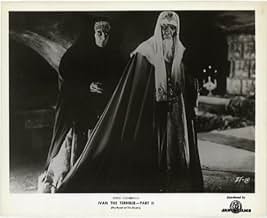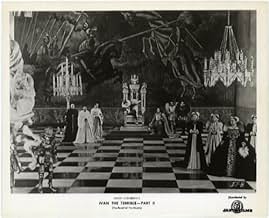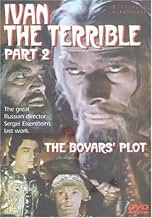Ivan le terrible - deuxième partie: La conjuration des boyards
Titre original : Ivan Groznyy. Skaz vtoroy: Boyarskiy zagovor
- 1946
- Tous publics
- 1h 28min
NOTE IMDb
7,7/10
8,5 k
MA NOTE
Alors qu'Ivan le Terrible tente de consolider son pouvoir en créant une armée personnelle, ses rivaux politiques, les boyards russes, complotent pour assassiner leur tsar.Alors qu'Ivan le Terrible tente de consolider son pouvoir en créant une armée personnelle, ses rivaux politiques, les boyards russes, complotent pour assassiner leur tsar.Alors qu'Ivan le Terrible tente de consolider son pouvoir en créant une armée personnelle, ses rivaux politiques, les boyards russes, complotent pour assassiner leur tsar.
- Réalisation
- Scénario
- Casting principal
- Récompenses
- 1 nomination au total
Vsevolod Pudovkin
- Nikolay the Fanatic
- (as V.I. Pudovkin)
Ada Voytsik
- Elena Glinskaya, Ivan's Mother
- (as Ada Vojtsik)
Aleksandr Rumnev
- The Stranger
- (non crédité)
Avis à la une
It's great art.Eisenstein can be compared to Michelangelo,no less.Needless to say,you've got to see part one -slightly inferior to this one,but what does it mean,when you' re watching the seventh art at the height of its terrible powers?-.This part focuses on the feud between Ivan and his aunt who tries to replace him by an effeminate imposter of her choice.Prokofiev music gives the feeling of watching an opera,the scenes in the cathedral recreate a mystery as it was in the Middle Ages as faithfully as you can wish.The peak of the movie remains the banquet,shot in color,thanks to spoils of war film.So stunning is Eisenstein's mastery of the picture that you can hardly exactly tell when the color returns to black and white (which for the final becomes a color in itself)Ivan's last soliloquy might seem aggressive and chauvinistic.But you've got to remember that the USSR were at war at the time ."Ivan" is timeless ,a monument that's as awesome today as it was for its -deleted,because of Stalin- 1958 release.
10rnair
This space can't afford me the kind of gargantuan platform needed to speak on Eisenstein's masterwork (both parts) with the sort of attention to detail and passion that the director brings to the story of the Russian tsar. This is the rarest of films that stands as a testament to how cinema can extend beyond an entertainment and exist as a singular work of art and a document that works to expand our knowledge of the human condition. Every frame is rich, every scene speaks far more than any written line or action. The production is a phenomenal achievement in the absolute totality of the collaborative effort; the actors, the set, the cinematography, the soundtrack - every facet of the film-making process has worked to create a seamless connection. While the approach of the actors, the lighting and the choices of camera angles frustrate our standard ideas of what a movie should look and feel like, there is a design here; it is precise and it is brilliant. This is a film for those viewers who, as Eisenstein famously said, read (not just watched) the images on the screen. One of the two or three true masterworks in the history of movies.
Ivan the Terrible marks the final stages of the cinema's greatest creative genius: SERGI EISENSTEIN. It is the work of a director, a supreme artist who never ceased in probing new boundires, striking out uncharted paths, and searching the outer limits of his art. In the work, Eisenstein has gone eons beyond his earlier methods of film creation and for the first time approaches a true synthesis of dance, music, poetry, painting, photography, architecture, and all other forms of aesthetic communication.
The trials and tribulations surrounding the production and distribution of Ivan have become legendary in there own right. The film drew sharp criticism from Stalin and Eisenstein was forced to publicly announce his ''formalist errors.'' Subsequently, the film was banned in Russia until 1958 and Eisenstein was ostracized for what many saw as a film full of ''excess.'' It took many years before the world would come to realize it is nothing short of his greatest masterpiece.
A true cinematic realization of the ever elusive ''total work of art.'' A concept that originated with the Ancient Greeks and was further formulated by Richard Wagner in his epic masterwork, ''THE RING CYCLE.'' The Gestanmueack or ''intragel work of art'' as Wagner called it was in essence the synthesizing of every artistic medium into a single polyphonic experience. In the 20th century Eisenstein saw Wagner's music dramas as predecessors of cinema; a cinema that synthesized elements of all of mankind's arts into a single majestic, visceral and emotional experience which could transform and transfix the spectator. Together with the world renowned composer, master Sergei Prokofiev, and his lifelong cinematographer Eduard Tisse, Eisenstein labored for years researching and planning out every camera angle, lighting scheme, musical note, costume, color palette, gesture, and perspective; until every scene in Ivan becomes an intricate and complex world of its own. A world where actors twist and bend their forms to the limits of the plastic frame, shadows conceal and light reveals, the musical notes flow with the rhythm and tempo of the visual image and in the famous banquet scene, colors are used by Eisenstein to delve into the psychological states of the character's mind and state of being. It becomes a universe composed so precisely and diligently that every frame is infused with hidden metaphorical and symbolic meanings, and serves to create the epitome of cinematic achievement.
Tragically, like Schubert's great ''Unfinished Symphony'' or the Venus di Milo, Eisenstein passed away before completing the final part of his epic masterwork. What remains of Ivan the Terrible will live forever as a testament not only to the genius of Sergei Eisenstein but also to his unparalleled contribution to the world culture of the 20th century.
The trials and tribulations surrounding the production and distribution of Ivan have become legendary in there own right. The film drew sharp criticism from Stalin and Eisenstein was forced to publicly announce his ''formalist errors.'' Subsequently, the film was banned in Russia until 1958 and Eisenstein was ostracized for what many saw as a film full of ''excess.'' It took many years before the world would come to realize it is nothing short of his greatest masterpiece.
A true cinematic realization of the ever elusive ''total work of art.'' A concept that originated with the Ancient Greeks and was further formulated by Richard Wagner in his epic masterwork, ''THE RING CYCLE.'' The Gestanmueack or ''intragel work of art'' as Wagner called it was in essence the synthesizing of every artistic medium into a single polyphonic experience. In the 20th century Eisenstein saw Wagner's music dramas as predecessors of cinema; a cinema that synthesized elements of all of mankind's arts into a single majestic, visceral and emotional experience which could transform and transfix the spectator. Together with the world renowned composer, master Sergei Prokofiev, and his lifelong cinematographer Eduard Tisse, Eisenstein labored for years researching and planning out every camera angle, lighting scheme, musical note, costume, color palette, gesture, and perspective; until every scene in Ivan becomes an intricate and complex world of its own. A world where actors twist and bend their forms to the limits of the plastic frame, shadows conceal and light reveals, the musical notes flow with the rhythm and tempo of the visual image and in the famous banquet scene, colors are used by Eisenstein to delve into the psychological states of the character's mind and state of being. It becomes a universe composed so precisely and diligently that every frame is infused with hidden metaphorical and symbolic meanings, and serves to create the epitome of cinematic achievement.
Tragically, like Schubert's great ''Unfinished Symphony'' or the Venus di Milo, Eisenstein passed away before completing the final part of his epic masterwork. What remains of Ivan the Terrible will live forever as a testament not only to the genius of Sergei Eisenstein but also to his unparalleled contribution to the world culture of the 20th century.
Ivan the Terrible Part II, the culmination of Eisenstein's career, is easily one of the most brilliant films of all time.
Nothing - repeat absolutely nothing - in this film is sub-par. The acting, especially the inhuman physical contortions of Nikolai Cherkasov as the Tsar himself, is uniformly excellent. As is to be expected from Eisenstein, the direction is perfect. Eisenstein's compositions create painterly tableaux that can be watched endlessly on pause (especially now that Criterion has issued both Ivans on DVD), allowing the audience to take in the full breadth of this man's genius. Additionally, unlike, for example, Alexander Nevsky or Strike, Ivan the Terrible Part II (and part I) benefits from a smoother pace and better editing, putting Eisenstein's theory of montage to its best use since Potemkin.
For me, however, what two key components of this film set it apart from its prequel and Eisenstein's earlier Potemkin and October.
Those components, as you can imagine, are its more pronounce political allegory and its color sequence towards the end.
Certainly October and Potemkin were highly politicized affairs, both celebrating the Communist victory in Russia. In Ivan the Terrible Part II (and to a lesser extent Part I), the audience bears witness to a moment of challenge wherein Eisenstein becomes critical of the course his country and its post-Lenin leaders have taken. As such, Ivan the Terrible becomes one of the bravest moments in film history and, for that alone, should be commended.
Brilliant as a political critique, the film also represents a dazzling demonstration of how color could be used in cinema. The colorized dance at the end of the film rivals and prefigures the technicolor explosion in Douglas Sirk's 1950s melodramas; furthermore, it reveals that color can be used to achieve specific effects. It does not have to mimic reality; rather it can be used artistically to enhance the mood and atmosphere of the film.
Taken as a whole, the two-part Ivan the Terrible is a masterpiece of Russian Cinema and should be required viewing for anyone with the slightest bit of interest in film. My preference lies with the second part, but both are fantastic moments in film history.
Nothing - repeat absolutely nothing - in this film is sub-par. The acting, especially the inhuman physical contortions of Nikolai Cherkasov as the Tsar himself, is uniformly excellent. As is to be expected from Eisenstein, the direction is perfect. Eisenstein's compositions create painterly tableaux that can be watched endlessly on pause (especially now that Criterion has issued both Ivans on DVD), allowing the audience to take in the full breadth of this man's genius. Additionally, unlike, for example, Alexander Nevsky or Strike, Ivan the Terrible Part II (and part I) benefits from a smoother pace and better editing, putting Eisenstein's theory of montage to its best use since Potemkin.
For me, however, what two key components of this film set it apart from its prequel and Eisenstein's earlier Potemkin and October.
Those components, as you can imagine, are its more pronounce political allegory and its color sequence towards the end.
Certainly October and Potemkin were highly politicized affairs, both celebrating the Communist victory in Russia. In Ivan the Terrible Part II (and to a lesser extent Part I), the audience bears witness to a moment of challenge wherein Eisenstein becomes critical of the course his country and its post-Lenin leaders have taken. As such, Ivan the Terrible becomes one of the bravest moments in film history and, for that alone, should be commended.
Brilliant as a political critique, the film also represents a dazzling demonstration of how color could be used in cinema. The colorized dance at the end of the film rivals and prefigures the technicolor explosion in Douglas Sirk's 1950s melodramas; furthermore, it reveals that color can be used to achieve specific effects. It does not have to mimic reality; rather it can be used artistically to enhance the mood and atmosphere of the film.
Taken as a whole, the two-part Ivan the Terrible is a masterpiece of Russian Cinema and should be required viewing for anyone with the slightest bit of interest in film. My preference lies with the second part, but both are fantastic moments in film history.
10zetes
There is not a single criticism I could make for either Ivan the Terrible Film. They are perfect films, original, effective, and affecting. Perhaps the two best films ever made. If not, they're to be included on my list of totally invaluable films, with not a doubt in my mind.
II begins exactly where I ends. Ivan has consolidated his power in Moscow, at least with the people (though not with the nobles, or "boyars"). In fact, what power he has inspires jealousy and fear in the boyars.
Ivan I builds Ivan up as a noble character. We despise the boyars for their flagrant wealth and greed, and we like Ivan for supporting the people. His closest comrades seem like Homeric heroes.
Ivan II develops Ivan's character even further. He may have power, but he still feels alone on the throne. His two greatest friends have left him, one gone to religion and one to the enemy. His immediate underlings, perceived as heroes in Ivan I, have grown paranoid and powerful. They convince Ivan to execute left and right. The only route for the boyars is to conspire Ivan's death.
Ivan II leads up to one of the single greatest climax I can think of. To heighten the effect, for the first time, Eisenstein opted to shoot in color. And as masterful as he was with black and white, he is also with color. The juxtaposition of color with black and white is absolutely amazing.
The only problem with the film is no one's fault. Part II ends, open for the third installment. Alas, Sergei Eisenstein would die before its completion. We're lucky enough to have Ivan the Terrible Part II, for Stalin demanded that it not be released theatrically, believing Ivan to be a portrait of himself. Eisenstein, in fact, never had the chance to see it released theatrically, was never to hear the lavish praise from critics the world round. Here I praise it, hoping that in the next world possibly Eisenstein can know what masterworks he made.
II begins exactly where I ends. Ivan has consolidated his power in Moscow, at least with the people (though not with the nobles, or "boyars"). In fact, what power he has inspires jealousy and fear in the boyars.
Ivan I builds Ivan up as a noble character. We despise the boyars for their flagrant wealth and greed, and we like Ivan for supporting the people. His closest comrades seem like Homeric heroes.
Ivan II develops Ivan's character even further. He may have power, but he still feels alone on the throne. His two greatest friends have left him, one gone to religion and one to the enemy. His immediate underlings, perceived as heroes in Ivan I, have grown paranoid and powerful. They convince Ivan to execute left and right. The only route for the boyars is to conspire Ivan's death.
Ivan II leads up to one of the single greatest climax I can think of. To heighten the effect, for the first time, Eisenstein opted to shoot in color. And as masterful as he was with black and white, he is also with color. The juxtaposition of color with black and white is absolutely amazing.
The only problem with the film is no one's fault. Part II ends, open for the third installment. Alas, Sergei Eisenstein would die before its completion. We're lucky enough to have Ivan the Terrible Part II, for Stalin demanded that it not be released theatrically, believing Ivan to be a portrait of himself. Eisenstein, in fact, never had the chance to see it released theatrically, was never to hear the lavish praise from critics the world round. Here I praise it, hoping that in the next world possibly Eisenstein can know what masterworks he made.
Le saviez-vous
- AnecdotesThis film was withheld by Soviet authorities by order of Joseph Stalin, since this film, dealing with Ivan's slide into madness and the tyranny of the Oprichnina, did not properly mythologize Ivan IV Grozny to Stalin's satisfaction. It was not finally released until 10 years after the deaths of director Sergei Eisenstein and Stalin.
- GaffesIn the movie young Ivan IV is making a contract with the Livonian Brothers of the Sword. However it didn't exist since the 7th June 1238, almost 300 years before Ivan was born.
- Citations
Czar Ivan IV: From now on I will become the one you call me. I will become terrible.
- Crédits fousThe main cast and their roles is read by the narrator with accompanied footage.
- ConnexionsFeatured in The Secret Life of Sergei Eisenstein (1987)
Meilleurs choix
Connectez-vous pour évaluer et suivre la liste de favoris afin de recevoir des recommandations personnalisées
Détails
- Date de sortie
- Pays d’origine
- Langue
- Aussi connu sous le nom de
- Ivan the Terrible, Part II: The Boyars' Plot
- Lieux de tournage
- Sociétés de production
- Voir plus de crédits d'entreprise sur IMDbPro
Box-office
- Montant brut mondial
- 1 655 $US
- Durée
- 1h 28min(88 min)
- Couleur
- Mixage
- Rapport de forme
- 1.37 : 1
Contribuer à cette page
Suggérer une modification ou ajouter du contenu manquant





















